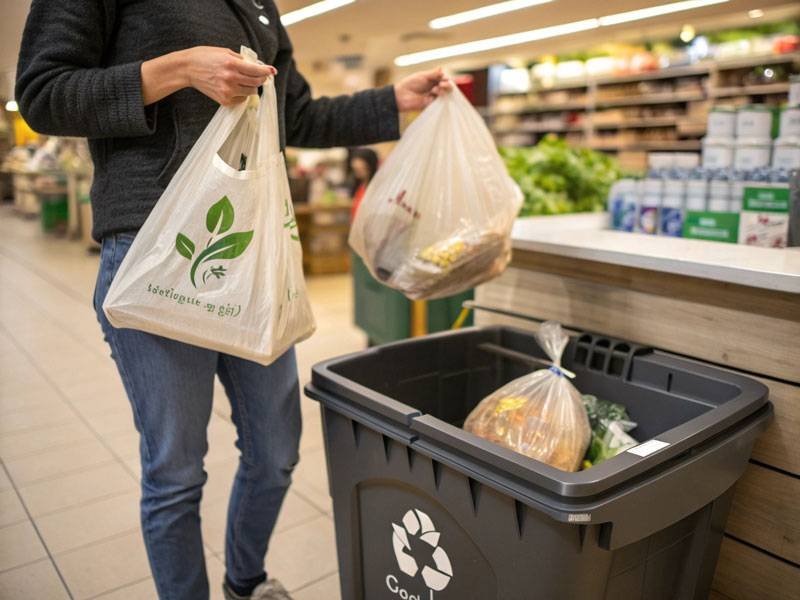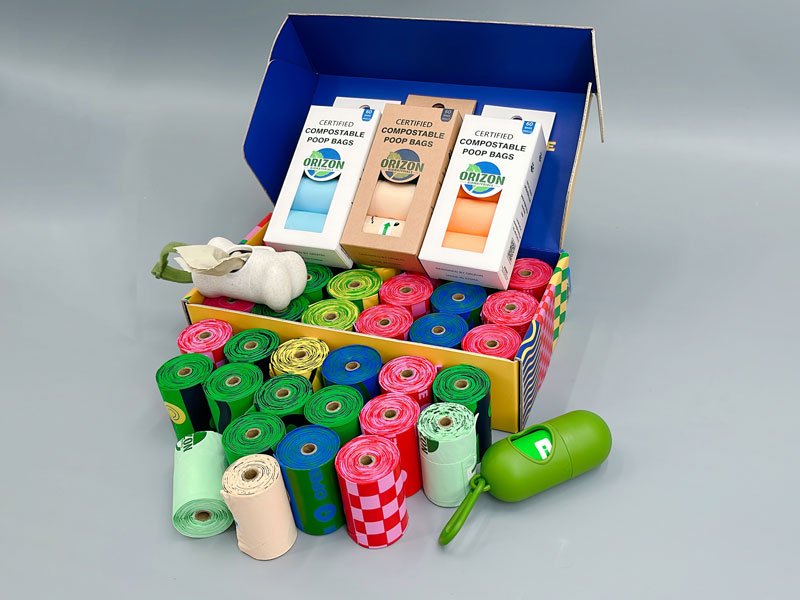As the world moves toward a more sustainable lifestyle, plastic alternatives are popping up everywhere, especially in the realm of packaging and single-use plastic bags. The terms “biodegradable” and “compostable” are often used interchangeably. But they’re not the same, and understanding the difference is crucial for anyone looking to make an eco-friendly choice.
In this article, we’ll break down everything you need to know about biodegradable and compostable plastic bags, including how they work, what they’re made of, and which one is better for the planet.
 environmentally friendly garbage bags
environmentally friendly garbage bags
What Are Biodegradable Plastic Bags?
Biodegradable plastic bags are designed to break down into natural elements like water, carbon dioxide, and biomass through microbial activity. However, the term “biodegradable” is not well-regulated, which leads to a wide range of products claiming to be eco-friendly with minimal substantiation.
Materials Used:
Most biodegradable bags are made from traditional petroleum-based plastics like polyethylene (PE) with chemical additives (often called oxo-degradable or oxo-biodegradable). These additives promote fragmentation when exposed to light, heat, or oxygen.
How They Break Down:
These bags break down over time but often require specific environmental conditions—like UV light or high heat—which are rarely met in landfills. The resulting fragments may be invisible but can persist as microplastics.
Pros:
- Slightly better than conventional plastic
- May degrade faster under certain conditions
- Often cheaper than compostable alternatives
Cons:
- Often leave microplastics behind
- Rarely break down in landfills or marine environments
- Misleading marketing can lead to improper disposal
What Are Compostable Plastic Bags?
Compostable plastic bags are made to fully decompose into non-toxic elements in composting environments—leaving behind carbon dioxide, water, and nutrient-rich biomass without any residue.
Materials Used:
Common materials include:
- PLA (Polylactic Acid) derived from cornstarch or sugarcane
- PBAT (Polybutylene adipate terephthalate)
- Starch-based blends
These are often certified according to industrial composting standards like ASTM D6400, EN 13432, or AS 4736.
Breakdown Process:
Compostable bags require specific conditions:
- High temperature (above 55°C/131°F)
- Controlled humidity
- Active microbial presence
In industrial composting facilities, they break down within 90–180 days.
Pros:
- Break down into harmless organic matter
- Do not create microplastics
- Recognized by global composting certifications
Cons:
- Need industrial composting to degrade properly
- Home compostable options are limited and slower
- Shorter shelf life due to material sensitivity
 compostable vs plastic bags
compostable vs plastic bags
Key Differences: A Side-by-Side Comparison
| Feature | Biodegradable Plastic Bags | Compostable Plastic Bags |
|---|---|---|
| Raw Materials | Petroleum-based with chemical additives | Plant-based (PLA, PBAT, starch) |
| Breakdown Conditions | Variable; often incomplete | Requires industrial or home compost environment |
| Breakdown Time | Months to years | 90–180 days (industrial); 6–12 months (home) |
| Byproducts | May leave microplastics | CO₂, water, biomass |
| Environmental Certifications | Few or none | BPI, TÜV Austria, EN 13432, ASTM D6400 |
| Final Decomposition Result | Fragmented plastic | Non-toxic organic matter |
| Disposal Path | Landfill, sometimes recycling | Compost bin (where accepted) |
Environmental Impact: Which Is Better?
Biodegradable Bags
Biodegradable plastic bags, especially oxo-degradable types, are controversial. They often degrade into smaller plastic particles rather than disappearing entirely. These microplastics can contaminate soil, waterways, and even food chains.
Moreover, biodegradable plastics are often dumped in landfills where oxygen and microbial activity are limited. Under these conditions, they may emit methane—a potent greenhouse gas—while degrading slowly or not at all.
Compostable Bags
Compostable bags, when disposed of correctly in industrial composting facilities, break down into organic matter with no lasting impact. They enrich the soil and reduce reliance on fossil fuels.
However, compostable bags require proper collection systems. If thrown in the trash or sent to a landfill, they will not break down as intended and may behave similarly to traditional plastics.
Verdict:
Compostable bags are the better environmental choice—but only when proper composting infrastructure is available and the bags are correctly disposed of.
How to Tell If a Bag Is Truly Compostable or Biodegradable
1. Look for Certifications
Compostable plastic bags should be labeled with one or more of the following:
- BPI (US) – Meets ASTM D6400
- TÜV Austria (EU) – OK Compost INDUSTRIAL or OK Compost HOME
- EN 13432 (EU) – Compostability standard for packaging
- AS 4736 (Australia) – Industrial compost standard
- AS 5810 – Home compostable standard (Australia)
Biodegradable bags often lack credible third-party certification. Beware of vague terms like “eco,” “green,” or “degradable” without proof.
2. Material Disclosure
- Compostable bags are typically made from PLA, PBAT, or starch blends.
- Biodegradable bags may still be polyethylene-based.
3. Avoid Greenwashing
Some brands market bags as “100% degradable” without explaining the process or end results. Always check for real standards and avoid oxo-degradable plastics unless thoroughly certified.
Best Use Cases for Each Type of Bag
Compostable Plastic Bags:
- Food Waste Collection: Perfect for municipal organic recycling programs
- Retail Bags: For eco-conscious customers
- Dog Waste Bags: When used with compostable waste programs
- Mailers & Packaging: Sustainable e-commerce fulfillment
Biodegradable Plastic Bags:
- Short-Term Packaging: For dry goods or temporary use
- Landfill Waste: Where no composting options are available
- Rural or Unregulated Markets: Where industrial composting isn’t feasible
Common Misconceptions
“Biodegradable bags can go into the compost bin.”
Not true. Unless the bag is certified compostable, it could contaminate the compost with plastic residue.
“Compostable bags degrade anywhere.”
False. Most compostable bags need controlled conditions (moisture, temperature, microbes) found in industrial composting facilities.
“Home compostable means fast breakdown.”
Home compostable bags still take months to fully degrade—typically 6 to 12 months.
“Both types are plastic-free.”
Incorrect. Many biodegradable bags contain plastic derivatives. Only certified compostable bags are genuinely plastic-free.
Which bag is right for you
If you have access to composting facilities, choose certified compostable bags.
If your waste goes to landfill or you lack composting infrastructure, compostable bags may not provide real benefits.
If your goal is to reduce plastic pollution, compostable bags are a better choice.
If you are worried about budget, biodegradable plastic bags may be cheaper, but will come with long-term environmental costs.
For businesses, choosing compostable plastic bags demonstrates a stronger commitment to sustainability – especially when backed by third-party certification and clear product labeling.
Conclusion
Biodegradable and compostable plastic bags may sound similar, but their performance, composition and environmental impact are very different. Biodegradable plastic bags can partially degrade, but often leave microplastics. Compostable plastic bags, on the other hand, can completely decompose under the right conditions without harming the planet.
If you really want to reduce plastic waste, compostable plastic bags are the best choice when paired with the right disposal system.
Call to Action
Looking for certified compostable plastic bags for your brand or business? At Orizon Biomaterials, we manufacture eco-friendly, compostable bags with globally recognized certifications like BPI, EN13432, TÜV Austria, AS4736, and ASTM D6400.
✅ 16+ years of experience
✅ 20,000㎡ factory
✅ OEM & private label support
✅ Exporting to the US, EU, Australia & more
👉 Contact us today to request samples or discuss your custom compostable bag needs.



